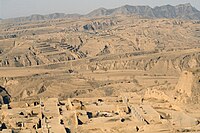
Photo from wikipedia
The formation and evolution of the landscape of the Chinese Loess Plateau (CLP) is debated because of uncertainties regarding dust provenance. We present a quantitative estimation of dust source contributions… Click to show full abstract
The formation and evolution of the landscape of the Chinese Loess Plateau (CLP) is debated because of uncertainties regarding dust provenance. We present a quantitative estimation of dust source contributions to the CLP, based on more than 37,100 detrital zircon U-Pb ages, combined with mineral assemblages and isotope analyses. Our results reveal that the CLP was stepwise formed by ~8 million years (Ma) and is mainly composed of material from the Northeastern Qinghai-Tibetan Plateau, with stepwise shifts in relative contributions of different eolian silt sources occurring at ~2.6 Ma and 1.5 to 1.2 Ma. We infer that these changes were driven by stepwise global cooling, which induced aridification and enhanced silt production in glaciated-cold climate dust source regions, as well as dust ablation in the expanded arid regions. We propose that global cooling, rather than regional tectonic deformation, was the main driver of the formation and evolution of the CLP during late Cenozoic.
Journal Title: Science Advances
Year Published: 2022
Link to full text (if available)
Share on Social Media: Sign Up to like & get
recommendations!